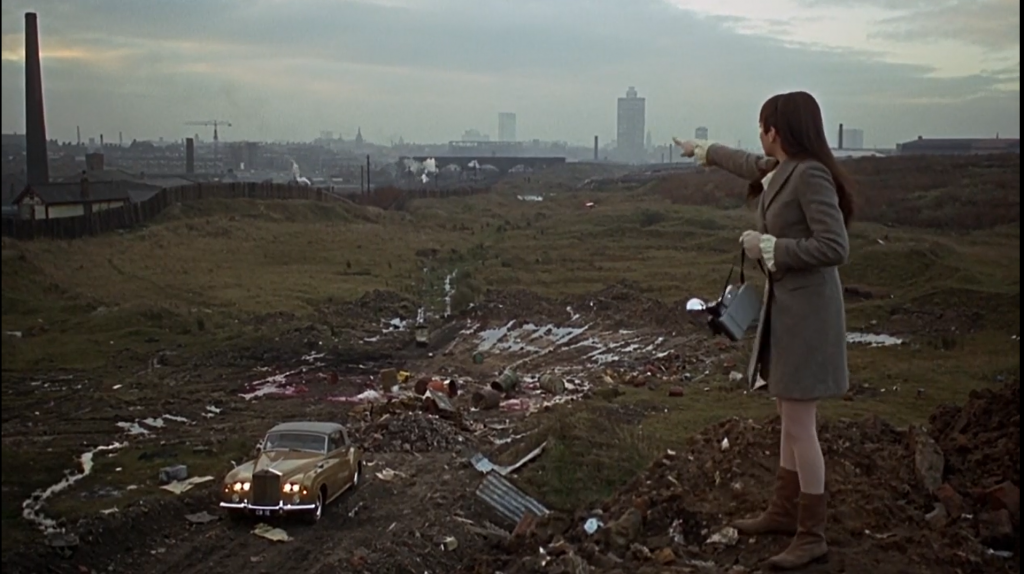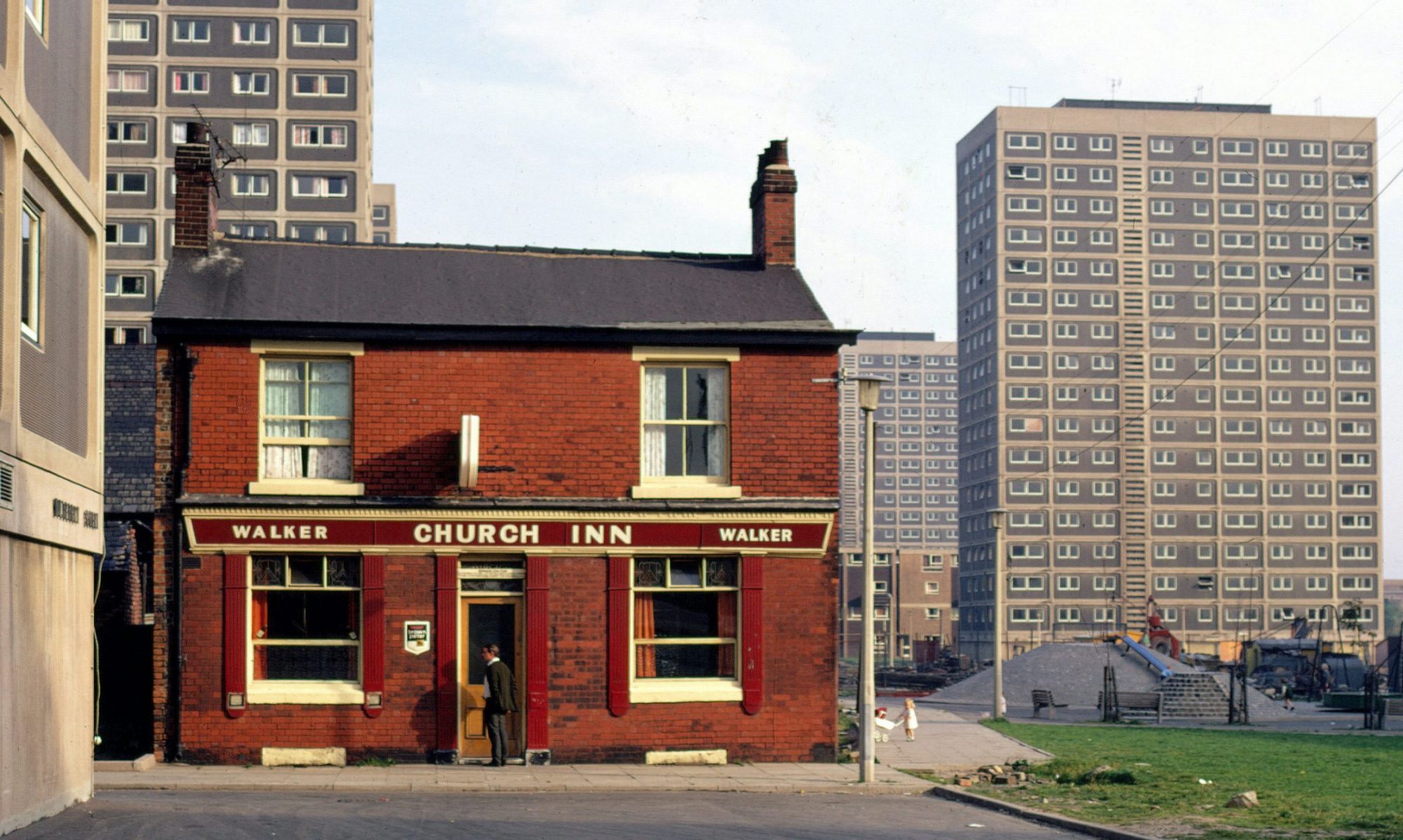by Chris Hughes
Chris Hughes is a graduate of the University of Salford and the University of Manchester, and a freelance political commentator, and founder of alt-politics https://www.alt-politics.co.uk/.
Background image: Ellor Street and Unwin Street area under redevelopment, c1960s, University Salford Photographic Archive, ULS/3/89
The Modern Backdrop is a project that has caught my interest and imagination, as a Salfordian. However, I am in one sense removed from the project since I was born in 1983, and the project is looking at the Salford just before I was born c.1950-1975. Therefore, I am writing as someone who currently lives in Salford, who was born here, grew up here and went to school here. However, I can’t reflect on the “slum clearances” and I am emotionally removed from that period of Salford’s past.
The Modern Backdrop project is a multi-facetted project that seeks to do many things in the process of analysing the transition of Salford from terraced housing, via slum clearance, to modern social housing projects from the late 1950s to the early 1970s.[i] Part of the project involves collecting new material in the form of the recollections of the people who experienced the “slum clearances”. Other aspects of the project involve using Salford as a case study to explore the planning transformations that were part of post-war “modernisation”. The Modern Backdrop also seeks to present its findings in a multimedia way, through a website, publications and exhibitions.
However, central aspects of the project seem to involve analysing: a) how Salford was represented and depicted on film and TV in the period; and b) how those representations affected perceptions of Salford. Attempting to unpick how perceptions of Salford have emerged from the representations of Salford opens up a number of different avenues of enquiry and various research questions. The most difficult would be to try to, in some sense, reconstruct the perceptions of Salford in the period from c.1950-1975. This will always be partial, as it would require relying on archival material. Possibly, more interesting and more fruitful lines of exploration involve trying to explore current perceptions of both Salford’s past, specifically the “slum clearances”, and perceptions of present-day Salford. Even this is a complex and fraught field of enquiry, since it involves both considering the perceptions of Salfordians about the representations of their City, and outsiders perceptions of Salford based on the representations of the City. It may also involve analysing the projections, correct or incorrect, that Salfordians believe are the perception of their City from outsiders.

In a previous blog post on The Modern Backdrop, Jonny Smith argued that Salford, more so than anywhere else in Britain, through its representations in film and TV, has come to viscerally encapsulate working-class life.[ii] However, I contest Smith’s notion that “Salford has never escaped this narrative and its cultural identity remains bound up in the iconography of 1960s film and television”[iii]. Firstly, I’m not sure that the films cited e.g. A Taste of Honey (1961), Charlie Bubbles (1968), and The White Bus (1967) are still widely viewed or still resonate in contemporary culture and consciousness; they are not necessarily stock images in the minds of people under 40. Secondly, there is an obvious lacuna in time from those films and the present-day, and therefore an awareness and understanding that the industrial landscape of Salford, like Britain, has morphed into a post-industrial landscape. Thus shots of the BBC studios, Media City and Salford Quays are likely to be the representations of Salford that people would use to draw on to formulate their perceptions about contemporary Salford. The representations of Salford in the 1950s-1970s will shape perceptions about the historic, industrial, working-class Salford, but the distance in time means that such representations are unlikely to have a great bearing on perceptions about present-day, post-industrial Salford. As a parallel, images of 1950s/60s London feature men in suits with bowler hats and umbrellas; this does not have much bearing on my perception and image of the London of today, as I am more likely to think of black culture and the Grime scene, as reference points for London.

Film and TV may not even be the most relevant medium to assess contemporary perceptions of historic Salford. The influence of representations on film and TV have a tendency to be transient and ephemeral, and whilst they may be impactful at the time of their transmission, they can be virtually unknown to a generation later. This certainly seems to be the case with the trio of films A Taste of Honey (1961), Charlie Bubbles (1968), and The White Bus (1967), and earlier representations of Salford in film, in the adaptations of Love on the Dole (1941) and Hobson’s Choice (1954). Coronation Street (1960 – ) is an obvious exception, because it is still running. Some films and TV shows from the 1960s do become part of the lexicon through which the past is perceived, but this usually requires that they are still regularly viewed, such as the Michael Caine film, The Italian Job (1969) or Steptoe and Son (1962-1974). Occasionally films or TV shows from the 1960s may not be viewed, because they are not considered suitable for re-transmission, but because they are frequently referenced in contemporary discussion they remain part of contemporary perceptions about the past, such as the “iconic” Alf Garnett character in Till Death Do Us Part (1965-1975). Thus, some representations of 1960s life on film and TV, through constant citation and re-iteration, become part of contemporary perceptions of the past and do shape contemporary cultural perceptions of the 1960s. However, frequently representation on film and TV is rather ephemeral and transient. Representations of Salford in film and TV from the 1960s, with the exception of Coronation Street, no longer resonate in the public consciousness, which means it may be worth looking at other mediums to analyse contemporary perceptions about a past Salford.
Contemporary perceptions about the industrial Salford of the “slum clearance” era c.1950-1975 are probably derived from stills, rather than moving footage. Some of these stills may be taken from films, TV shows and documentaries of the time, but they also include photographs from the time such as those of the photographer Shirley Baker. As well as stills, whether they be from photographic art, TV documentary, or from film, the most significant representations of Salford in the visual medium are the paintings of L.S. Lowry. In terms of legacy, Lowry’s representations of Salford are probably more crucial than the films/TV shows from the era in formulating current perspectives about a historic, industrial Salford. Lowry paintings are still widely viewed, and Lowry is very much a part of contemporary culture and consciousness. Lowry’s paintings of Salford span a very long time period from just before World War I right up to his death in 1976. The name Lowry is known in all segments of contemporary British life, high culture and low culture; and, aside from J.M.W Turner, Lowry is one of the most well-known artists to have painted in Britain. Thus any attempt to grapple with the representation of Salford in the “slum clearance” era c.1950-1975, without reference to Lowry would be incomplete.
The Modern Backdrop is primarily interested in representations and perceptions of Salford in the period of the “slum clearances”. However, an interesting additional area of research might be to consider what are the current reference points in terms of the representation of Salford that make-up the cultural consciousness; what are the things within contemporary, post-industrial Salford that affect perceptions about the current City? Following on from working out what the reference points are that determine the representation of present-day Salford, the obvious question that follows is: how do these representations affect perceptions about present-day Salford? This, again, involves 3 levels: the perceptions of Salfordians about the representations of their City; outsiders perceptions of Salford based on representations of the City, and the projections, correct or incorrect, that Salfordians believe are the perception of their City from outsiders.
[i] About the Project – The Modern Backdrop (salford.ac.uk)
[ii] “We Cannot Cling to the Old Dreams Anymore”: Exploring Post-War Change in Salford in Film & Television – The Modern Backdrop
[iii] “We Cannot Cling to the Old Dreams Anymore”: Exploring Post-War Change in Salford in Film & Television – The Modern Backdrop


